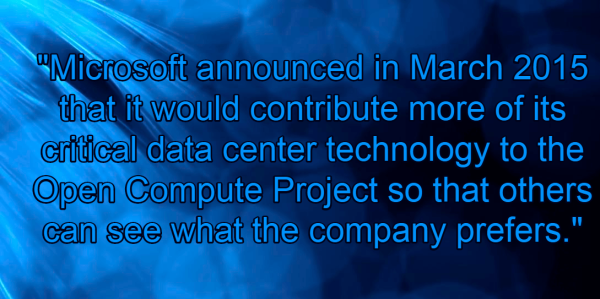Data Centers Benefit From The Open Compute Project


Mark Shuttleworth, the founder of both Ubuntu and Canonical asked the attendees of the Open Compute Summit 2015 this question, “Can you integrate profound change into your environment?”
The founder of the Open Compute Project, Frank Frankovsky, worked at Facebook. With the support of Facebook, they started to Open Compute Project Foundation in 2009. This was a bold decision by Facebook because they decided to share information about their network infrastructure with others.
Sounds like a simple concept to share the protocols of hardware and software connectivity to improve efficiencies of network transmissions. The surprising thing is that prior to the bold move by Facebook, other heavy Internet bandwidth users like Google for example, never shared with anyone how they managed their network data flow to maximize efficiency.
When it comes to Internet usage, the Open Commute Project initially targeted the largest Internet users. These companies could calculate return on investment based on network efficiencies. They process billions of Internet web page requests every day. A savings in cost or a small improvement in network efficiency at the data center has a direct positive impact on the bottom line of these companies. All of them face the same challenges and all benefit from improvements in network efficiency.
To solve this problem using the best minds, which were scattered amongst all the various gigantic companies, takes collaboration. This is a case of the metaphor of the “incoming tide rises all boats,” because there is less competitive advantage gained from holding the network efficiency information private in comparison to seeing how others are solving the problem. This is because others may have solved parts of the problem in innovative ways that are extremely useful.
The project started at Facebook with only seven people. The first thing they did was design a piece of hardware that they called “Freedom.” The Freedom hardware ran on open source software code, so any software engineer could see how it works and make improvements in the design. This concept went viral and expanded exponentially, so much so there is an official Open Compute Project association and an annual “Hardware Freedom Day.”
Once the large international corporations got involved and supported the project, this created a huge amount of cooperative behavior amongst network engineers, software developers, and hardware manufacturers.

The Facebook news, reported by Data Center Knowledge is that this initiative has saved the Facebook company billions of dollars in the costs of maintaining its network and operations. Other companies have also benefited. Microsoft announced in March 2015 that it would contribute more of its critical data center technology to the Open Compute Project so that others can see what the company prefers.
Equipment manufacturers jumped on board to service the needs of customers wanting to change network equipment to operate on the more efficient Open Compute systems architecture. Cloud computing benefited, because so much of the cost of cloud computing is the bandwidth of the Internet usage.
The initiative started at Facebook took less than two years to gain significant momentum. As reported by PCWorld, the Open Compute Project broke the confidentiality bonds between communication of network hardware and the efficiencies of software protocols that blocked innovation for decades. Virtually every data center can benefit from embracing the Open Compute Project.
Katrina in addition to her work with rack solutions Katrina has a video series featured on Youtube called ask Katrina that aids in answering your IT needs.
